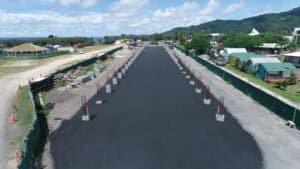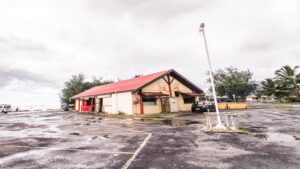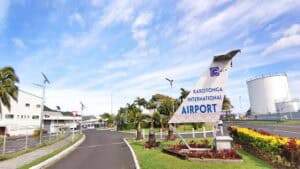Past experience has proven that successful projects are often driven and implemented largely by the community in which they will serve.
This is especially the case where the Arutanga Harbour Project is concerned.
The blessing of the new crane for Aitutaki Ports on Monday 12 December, marks the completion of Phase I and officially launches Phase II of the Arutanga Harbour Project.
Driven by Cook Islands Investment Corporation (CIIC), the Cook Islands Ports Authority (CIPA) and the Aitutaki Island Government, the central aim of the Arutanga Harbour Project is to improve the safety and usability of the harbour and port. The Arutanga Harbour project formed part of the Orongo Development Masterplan in 2011, as well as the Te Tau Papa o Araura-Aitutaki Plan, approved by the Island Council in 2019.
The project allows for the continuous flow of cargo to the island and safe passage for small ships, yachts, and cruise ship tenders.
CIIC board chairperson Fletcher Melvin says Phase I was about moving silt out of the channel and basin, widening, and deepening of the channel and inner harbour area to enable safe passage for shipping services and new tourism development opportunities.
The project involved dredging the harbour channel to a depth of five metres and a width of 15 metres, stretching along the channel’s entire 980 metre length from the entry point to Aitutaki Port.
At the start of Phase I, it was estimated that 70,000 cubic metres of mud and sand would be removed to be used for improvements around the port and for other community projects including resealing the Aitutaki Airport runway.
By the end of Phase I, a total of 150,000 cubic metres was removed, twice as much as what was first anticipated. We were able to deliver this extra material for extra infrastructure projects including the coastal area around the port, to a number of community reserves and projects, and to many households around Aitutaki.
Minister for Cook Islands Investment Corporation and Cook Islands Ports Authority, the Honourable Albert Nicholas says this is an important step in the right direction in terms of ensuring resilient and efficient infrastructure for Aitutaki.
The new crane for Aitutaki is also a clear indication of the Cook Islands Government’s commitment to ensuring the people and businesses of Aitutaki can continue to thrive and maintain the island’s positive and significant contribution to economic recovery and the overall economic performance of our nation as a whole, Mr Nicholas says.
Mr Fletcher says Phase II entails the installation of 70m of sheet piling, an extension to the port concrete hardstand, the installation of culverts to enable optimal water flow in and out of the inner harbour areas and other surrounding port and marina improvements.
“Phase II is of great importance to both the government and community as it will enable the provision of additional land for effective and efficient port operations – for container loading, storage and working areas across the main ports area – and for broadening the economic and social development opportunities for the people of Aitutaki.”
Both Mr Nicholas and Mr Fletcher congratulated all those involved in completion of Phase I of a project that is “For Aitutaki, by Aitutaki, in particular the local community.
“The Arutanga Harbour Project has been implemented and is being made possible by Aitutakians and the local community.
“This milestone event marks a significant and momentous day for you all – the people of Araura enua.”



